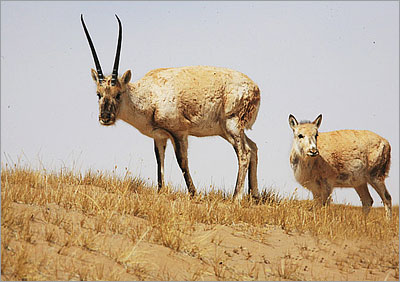 |
China is one of the countries with the greatest diversity of wildlife in the world. There are more than 6,266 species of vertebrates, 10 percent of the world's total. Among them 2,404 are terrestrials and 3,862 fishes. There are more than 100 wild animal species unique to China including such well-known rare animals as the giant panda, golden-haired monkey, South China tiger, brown-eared pheasant, red-crowned crane, red ibis, white-flag dolphin and Chinese alligator. The black-and-white giant panda weighs on average 135 kg and lives on tender bamboo leaves and bamboo shoots. Because it is extremely rare - just over 1,500 are left at present - it has become the symbol of the world's protected wild animals. The red-crowned crane, that could be as tall as 1.2 m, is covered with white feathers, with a distinctive patch of exposed red skin crowning its head and is regarded as a symbol of longevity in East Asia. The white-flag dolphin is one of only two species of freshwater whales in the world. In 1980, a male white-flag dolphin was caught for the first time in the Yangtze River, which aroused great interest among dolphin researchers worldwide.
China is also one of the countries with the most abundant plant life in the world. There are more than 32,000 species of higher plants, and almost all the major plants that grow in the northern hemisphere's frigid, temperate and tropical zones are represented in China. In addition, there are more than 7,000 species of woody plants, including 2,800-odd tree species. The metasequoia, Chinese cypress, Cathay silver fir, China fir, golden larch, Taiwan fir, Fujian cypress, dove-tree, eucommia and camplotheca acuminata are found only in China. The metasequoia, a tall species of arbor, is considered to be one of the oldest and rarest plants in the world. The golden larch, one of only five species of rare garden trees in the world, grows in the mountainous areas in the Yangtze River valley. Its coin-shaped leaves on short branches are green in spring and summer, turning yellow in autumn. China is home to more than 2,000 species of edible plants and over 3,000 species of medicinal plants. Ginseng from the Changbai Mountains, safflowers from Tibet, Chinese wolfberry from Ningxia and notoginseng from Yunnan and Guizhou are particularly well-known Chinese herbal medicines. China has a wide variety of flowering plants; the peony, a flower indigenous to China and known as the "king of flowers," is characterized by large blossoms, multiple petals and bright colors, and is treasured as one of the country's national flowers.

